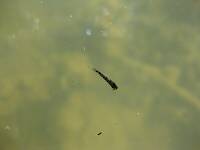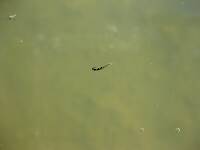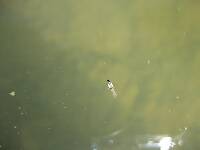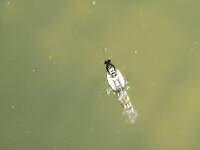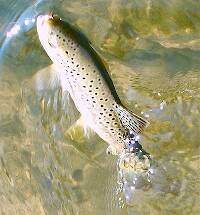
Salmonflies
Pteronarcys californica
The giant Salmonflies of the Western mountains are legendary for their proclivity to elicit consistent dry-fly action and ferocious strikes.
Featured on the forum

Nymphs of this species were fairly common in late-winter kick net samples from the upper Yakima River. Although I could not find a key to species of Zapada nymphs, a revision of the Nemouridae family by Baumann (1975) includes the following helpful sentence: "2 cervical gills on each side of midline, 1 arising inside and 1 outside of lateral cervical sclerites, usually single and elongate, sometimes constricted but with 3 or 4 branches arising beyond gill base in Zapada cinctipes." This specimen clearly has the branches and is within the range of that species.

Troutnut is a project started in 2003 by salmonid ecologist Jason "Troutnut" Neuswanger to help anglers and
fly tyers unabashedly embrace the entomological side of the sport. Learn more about Troutnut or
support the project for an enhanced experience here.
Byhaugh on Nov 17, 2015November 17th, 2015, 4:52 pm EST
What, specifically, allows the Caddis to depart the surface so much quicker than mayflies who wait to dry their wings?
Is it the different number of wings?
Is it a coating on the wings?
Is it wing protection when breaking the surface???
What exactly accounts for the difference?
Thanks
Is it the different number of wings?
Is it a coating on the wings?
Is it wing protection when breaking the surface???
What exactly accounts for the difference?
Thanks
Taxon on Nov 17, 2015November 17th, 2015, 9:16 pm EST
Hi Byron-
Most mayflies have (4) wings, as do caddisflies. However, it is my belief that caddisfly adults already have their wings expanded when they break through the meniscus, whereas most mayfly subimagos have to expand their wings after breaking through the meniscus, which is a more time consuming process.
Most mayflies have (4) wings, as do caddisflies. However, it is my belief that caddisfly adults already have their wings expanded when they break through the meniscus, whereas most mayfly subimagos have to expand their wings after breaking through the meniscus, which is a more time consuming process.
Crepuscular on Nov 18, 2015November 18th, 2015, 3:38 am EST
In addition to what Roger has stated, really the two insects are quite different other than wing number or shape, my speculation would be it has more to do with the type of metamorphosis the two orders go through.The caddisflies go through complete metamorphosis (egg, larva, pupa, adult) and mayflies go through incomplete metamorphosis, and most mayflies emerge from the nymphal exoskeleton as an "sexually immature" adult, morphologically this shouldn't be a hindrance to flight, but as Roger pointed out the wings of many mayflies do need time to unfold and fill with fluid (not "dry out"). This obviously takes more time than what is happening in the caddisflies who have spent time in the pupal stage and the wings have developed and the insect that emerges from the pupal case is a pretty much fully developed adult (pharate adult). This caddisfly has basically fully developed and very well working wings, and appendages which allow it to swim very rapidly to the surface and break through the meniscus rather easily. feel free to correct me if I have stated anything incorrectly.
Ctgene on Nov 19, 2015November 19th, 2015, 2:30 am EST
Haven't had time to look, but I believe LaFontaine had some thoughts on the subject. I believe it has something to do with the gas bubble. They do float a bit just not as long as some mayflies.
Gene
Gene
Feathers5
Posts: 287
Posts: 287
Feathers5 on Nov 19, 2015November 19th, 2015, 5:15 am EST
In addition to what Roger has stated, really the two insects are quite different other than wing number or shape, my speculation would be it has more to do with the type of metamorphosis the two orders go through.The caddisflies go through complete metamorphosis (egg, larva, pupa, adult) and mayflies go through incomplete metamorphosis, and most mayflies emerge from the nymphal exoskeleton as an "sexually immature" adult, morphologically this shouldn't be a hindrance to flight, but as Roger pointed out the wings of many mayflies do need time to unfold and fill with fluid (not "dry out"). This obviously takes more time than what is happening in the caddisflies who have spent time in the pupal stage and the wings have developed and the insect that emerges from the pupal case is a pretty much fully developed adult (pharate adult). This caddisfly has basically fully developed and very well working wings, and appendages which allow it to swim very rapidly to the surface and break through the meniscus rather easily. feel free to correct me if I have stated anything incorrectly.
Very well stated. It's a big help because I've made learning about caddis one of my priorities.
Martinlf on Nov 19, 2015November 19th, 2015, 12:12 pm EST
I think the gas bubble idea has been discounted, but may be wrong about this. We have a thread on this somewhere; I'll take a look.
"He spread them a yard and a half. 'And every one that got away is this big.'"
--Fred Chappell
--Fred Chappell
Ctgene on Nov 20, 2015November 20th, 2015, 3:39 am EST
Well I don't think Byron is getting his answer in regards to caddis emerging faster than other insects. Caddis do drift in the film and stay on the surface for a while, certainly not as long as some mayflies. As far a a gas bubble or small bubbles, I have success with LaFontaine patterns and will continue to use them. He spent many hours underwater observing caddis emerging. As far as other fly patterns such as those tied by Barr, Mercer and others they all try to incorporate flash to represent some sort of bubble. I suspect most will catch fish, some better than others.
Wbranch on Nov 20, 2015November 20th, 2015, 6:03 am EST
I think the gas bubble idea has been discounted
If in fact research has been conducted that invalidates the gas bubble issue it seems really weird that the main premise of Lafontaine's work, and book, about caddisflies is incorrect. I wonder what led him to believe in the bubble theory?
Catskill fly fisher for fifty-five years.
Ctgene on Nov 20, 2015November 20th, 2015, 7:47 am EST
WB, I just got out my copy of "Challenge of the Trout" published in 1976. In the chapter titled Thoughts On The Caddis he explains how he and friend go under water to visually watch caddis emerge. As Gary wrote in one sentence "it's selective feeding to the silver ball of the pupa." He further writes that it's the silver entrapment of air in its translucent sheath. He also claims that no fur or tinsel properly imitated this. He and friends did this underwater observation many many times testing different materials. At some point Gary tied some flies with with a knitting yarn called "Sparkle Yarn", basically a solid color with clear Anton fibers running through it. They did a check and the underwater observation showed some air bubbles trapped to the fly. If you can get a copy of this book I think it's one of the best fly fishing books written. Now with some of today's modern synthetics he may have some different thoughts on the subject. He passed away far too young. I fish his flies and have success with them and I will continue to do so.
Planettrout on Nov 22, 2015November 22nd, 2015, 5:56 am EST
I think the gas bubble idea has been discounted, but may be wrong about this. We have a thread on this somewhere; I'll take a look.
I think this might be the thread that covers the subject of gas bubbles/air bubbles/fluid reflection -GLF/Cutter/Borger etc...
http://www.troutnut.com/topic/2516/Caddis-Pupae-Question
In any case, Jon Barr's Graphic Caddis, with silver holographic tinsel wraps at the tip of the bulked out abdomen (under the micro tubing), is one of the most effective Caddis Pupa patterns I have ever used...
PT/TB
Daughter to Father: "How many arms do you have, how many fly rods do you need?"
http://planettrout.wordpress.com/
http://planettrout.wordpress.com/
Byhaugh on Nov 22, 2015November 22nd, 2015, 11:26 am EST
Thanks to all.
I am not looking for patterns.
I am trying to find out what the scientific reason(s) are for the observation that hatching caddis fly off the water so fast.......as compared to mayflies.
This observation has been chronicled for decades, which, in turn, led to the emphasis being placed on:
1. The rising pupal stage.
2 Ovipositing female imitations (under the theory they are on the surface longer. Sort of a "reverse hatch".
3. Crippled emergent caddis; i.e., X-Caddis, etc. which imitate the cripple with a trailing shuck, thus on/in the surface longer for a better target for trout
I am not looking for patterns.
I am trying to find out what the scientific reason(s) are for the observation that hatching caddis fly off the water so fast.......as compared to mayflies.
This observation has been chronicled for decades, which, in turn, led to the emphasis being placed on:
1. The rising pupal stage.
2 Ovipositing female imitations (under the theory they are on the surface longer. Sort of a "reverse hatch".
3. Crippled emergent caddis; i.e., X-Caddis, etc. which imitate the cripple with a trailing shuck, thus on/in the surface longer for a better target for trout
Crepuscular on Nov 22, 2015November 22nd, 2015, 1:14 pm EST
Well I don't think Byron is getting his answer in regards to caddis emerging faster than other insects.
I think Roger and I pretty much answered the question. For those caddis that do actually emerge faster than some mayflies, it really has to due with development prior to reaching the surface. By the way there are plenty of mayflies that leave the surface quickly as well and really I think that making the a blanket statement like all caddis flies leave the surface faster than mayflies is incorrect. Creno, can you weigh in on this one? I'm certainly no expert. And would love to hear your thoughts.
Oldredbarn on Nov 22, 2015November 22nd, 2015, 1:26 pm EST
Creno, can you weigh in on this one? I'm certainly no expert. And would love to hear your thoughts.
Me too...Dave...You want to help us out? :)
It's hard to get the trout to tell us why it does anything...It may be attracted to the deep sparkle pupa for reasons we will never know. It may have nothing to do with what Gary L thought...He may have observed something and within his own limitations described it, but there are limitations to inferences sometimes...After all he is a "mere" human as Sheldon Cooper likes to say. Can any one spell Heisenberg Uncertainty Principle? :)
In reference to "fast" exists by caddis, there is the species, which escapes my mind at the moment, that hikes across the surface for awhile...The so-called "travelling sedge".
Spence
"Even when my best efforts fail it's a satisfying challenge, and that, after all, is the essence of fly fishing." -Chauncy Lively
"Envy not the man who lives beside the river, but the man the river flows through." Joseph T Heywood
"Envy not the man who lives beside the river, but the man the river flows through." Joseph T Heywood
Byhaugh on Nov 22, 2015November 22nd, 2015, 1:31 pm EST
Sorry,
I took it to mean those were "possible" reasons. I can believe those would be the reasons. Just thought there might be more absolute Ness as to reasons.
Thanks
I took it to mean those were "possible" reasons. I can believe those would be the reasons. Just thought there might be more absolute Ness as to reasons.
Thanks
Crepuscular on Nov 22, 2015November 22nd, 2015, 4:23 pm EST
Sorry,
I took it to mean those were "possible" reasons. I can believe those would be the reasons. Just thought there might be more absolute Ness as to reasons.
Thanks
Absolutely no need to be sorry!
:) I think Creno would be able to give us the absoluteness.
And really it probably varies by genus or even species. Mayfly genera like Epeorus emerge from the nymphal shuck underwater, sometimes even on the bottom of the stream and swim to the surface as adults and emerge quickly (although E. pluralis takes a while sometimes). So as you can see by that example, it's hard to make generalizations.
Entoman on Nov 22, 2015November 22nd, 2015, 5:00 pm EST
Hi Byhaugh,
Reading this thread I have to say that between Taxon's and Crepuscular's contributions, the original question you posed couldn't be answered better or more thoroughly.
As for the validity of the concept of the shiny gas bubble pupa (that seems to be a recurrent question over and over) - it has been pretty much debunked.
That is not to say LaFontaine was mistaken in what he saw - only in interpreting the cause. Having spent a fair amount of time TRYING to observe underwater hatching activity of caddis, I can tell you it is quite difficult. These critters are tiny, well disguised when mixed with the flotsam and jetsam of stream drift, and often do their thing in swift water which greatly adds to the difficulty. My sense is that Gary's observations may have been due to the presence of diving adults. When rising for the surface they are quite visibly shiny and when they get there look like and engage in behavior not so different from the pupae (pharates) also usually present at the same time.
We have to remember that Gary was pioneering in this regard, with little to go on in the scientific lit to assist him on this topic at the time. The fact that he was probably wrong in ascribing this phenominum to the pupa doesn't really detract from his amazing contributions or the effectiveness of his patterns. If the diving adults are easier to see for us, so the trout. We all know that our quarry has an affinity for shiny little things... Anyway, his patterns have been fooling trout on a consistent basis for more than a generation - so does it really matter whether they are taken for pupa, diving adults, or attractors?
Now, there are times when fish can dial in on pupa (pharates). When they do, usually more imitative patterns of the pupa's true appearance are more effective.
Reading this thread I have to say that between Taxon's and Crepuscular's contributions, the original question you posed couldn't be answered better or more thoroughly.
As for the validity of the concept of the shiny gas bubble pupa (that seems to be a recurrent question over and over) - it has been pretty much debunked.
That is not to say LaFontaine was mistaken in what he saw - only in interpreting the cause. Having spent a fair amount of time TRYING to observe underwater hatching activity of caddis, I can tell you it is quite difficult. These critters are tiny, well disguised when mixed with the flotsam and jetsam of stream drift, and often do their thing in swift water which greatly adds to the difficulty. My sense is that Gary's observations may have been due to the presence of diving adults. When rising for the surface they are quite visibly shiny and when they get there look like and engage in behavior not so different from the pupae (pharates) also usually present at the same time.
We have to remember that Gary was pioneering in this regard, with little to go on in the scientific lit to assist him on this topic at the time. The fact that he was probably wrong in ascribing this phenominum to the pupa doesn't really detract from his amazing contributions or the effectiveness of his patterns. If the diving adults are easier to see for us, so the trout. We all know that our quarry has an affinity for shiny little things... Anyway, his patterns have been fooling trout on a consistent basis for more than a generation - so does it really matter whether they are taken for pupa, diving adults, or attractors?
Now, there are times when fish can dial in on pupa (pharates). When they do, usually more imitative patterns of the pupa's true appearance are more effective.
"It's not that I find fishing so important, it's just that I find all other endeavors of Man equally unimportant... And not nearly as much fun!" Robert Traver, Anatomy of a Fisherman
Crepuscular on Nov 22, 2015November 22nd, 2015, 5:07 pm EST
welcome back Entoman! Do you have any thoughts on the emergence "speed" of some caddis?
Entoman on Nov 22, 2015November 22nd, 2015, 6:14 pm EST
Hi Eric!
Thanks - though I have been lurking to keep up with my editorial duties, I haven't had time to post. Busy Fall... :)
Emergence speed? I think what sets the caddis apart is its swimming motion that's not unlike a water boatman or back swimmer. Other than that, it's similar (and also as varied) to mayfly emergence and not necessarily faster, depending on conditions. I've seen slow water and stillwater caddis either scamper across the surface or flop around more clumsily than a mayfly, often holding their wings erect in similar fashion after spending more than a minute extracting themselves from their juvenile skins... The giant October Caddis crawls along the bottom to specific hatching rocks (the picking of which is one of Nature's mysteries) where it crawls out to hatch in much the same way as the big stoneflies. Grannoms and hydropsychids usually drift along the bottom for varying distances and then ascend with their unique swimming motion. They also spend varying ammounts of time under and at the surface depending on conditions.
The concept of the "Super Caddis" emerging from its pupal cocoon and swimming to the surface with the explosiveness and speed of a Polaris missile is another myth. No "bursting" out of the cocoon. They'll drift, swim some, pause, swim some more... It varies.
Like many fast water mayfly species, the speed of current usually accelerates the timing. I've fished many times where PMD's got off the water so fast that they provided very poor dry fly sport as the fish focused exclusively on the easier to catch nymphs. This behavior is more common with caddis though.
Thanks - though I have been lurking to keep up with my editorial duties, I haven't had time to post. Busy Fall... :)
Emergence speed? I think what sets the caddis apart is its swimming motion that's not unlike a water boatman or back swimmer. Other than that, it's similar (and also as varied) to mayfly emergence and not necessarily faster, depending on conditions. I've seen slow water and stillwater caddis either scamper across the surface or flop around more clumsily than a mayfly, often holding their wings erect in similar fashion after spending more than a minute extracting themselves from their juvenile skins... The giant October Caddis crawls along the bottom to specific hatching rocks (the picking of which is one of Nature's mysteries) where it crawls out to hatch in much the same way as the big stoneflies. Grannoms and hydropsychids usually drift along the bottom for varying distances and then ascend with their unique swimming motion. They also spend varying ammounts of time under and at the surface depending on conditions.
The concept of the "Super Caddis" emerging from its pupal cocoon and swimming to the surface with the explosiveness and speed of a Polaris missile is another myth. No "bursting" out of the cocoon. They'll drift, swim some, pause, swim some more... It varies.
Like many fast water mayfly species, the speed of current usually accelerates the timing. I've fished many times where PMD's got off the water so fast that they provided very poor dry fly sport as the fish focused exclusively on the easier to catch nymphs. This behavior is more common with caddis though.
"It's not that I find fishing so important, it's just that I find all other endeavors of Man equally unimportant... And not nearly as much fun!" Robert Traver, Anatomy of a Fisherman
Creno on Nov 22, 2015November 22nd, 2015, 7:34 pm EST
The original Q is a great observation. And - absoluteness! I like that :-) so here is absoluteness - mayflies are lazy! It is obvious - mayflies have been around for about 100 million years longer than caddis. Yet there are only about 3000 species or so while there are more than 10,000 species of caddis. What have mayflies been doing - just floating around?
I probably should thank folks for the invite to respond, but I am afraid this thread is leading to a black hole :-) I have been thinking about, and looking into, the Q and have not really come up with anything. (although is is not the bubbles - whatever they are, or are not. I wonder how many times/ways a thread has lead to the bubbles....)
Perhaps, the answer is somewhere in the mayflies, not the caddis. If we are going to anthropomorphize you would think they would both want to avoid predators as best they could. Or, as Crepuscular pointed out - mayflies and caddis are different breeds. Maybe we can get a "rise" out of Konchu :-)
From an anecdotal perspective - I fished the Cheesman Canyon stretch of the South Platte and the Fryingpan below Ruedi (both below bottom release reservoirs) for over 20 years. The Baetis hatches were often amazing. Yet some days the dun left the water within seconds while other days they never left the water til they were eaten. In my mind the difference was the air temperature. When it was colder outside they took longer to fly - it was cold out. The fishable, surface emerging, caddis tend to emerge when it is warm out. Maybe we are comparing apples and oranges?
doubt this helps :-)
I probably should thank folks for the invite to respond, but I am afraid this thread is leading to a black hole :-) I have been thinking about, and looking into, the Q and have not really come up with anything. (although is is not the bubbles - whatever they are, or are not. I wonder how many times/ways a thread has lead to the bubbles....)
Perhaps, the answer is somewhere in the mayflies, not the caddis. If we are going to anthropomorphize you would think they would both want to avoid predators as best they could. Or, as Crepuscular pointed out - mayflies and caddis are different breeds. Maybe we can get a "rise" out of Konchu :-)
From an anecdotal perspective - I fished the Cheesman Canyon stretch of the South Platte and the Fryingpan below Ruedi (both below bottom release reservoirs) for over 20 years. The Baetis hatches were often amazing. Yet some days the dun left the water within seconds while other days they never left the water til they were eaten. In my mind the difference was the air temperature. When it was colder outside they took longer to fly - it was cold out. The fishable, surface emerging, caddis tend to emerge when it is warm out. Maybe we are comparing apples and oranges?
doubt this helps :-)
Byhaugh on Nov 23, 2015November 23rd, 2015, 7:32 am EST
Thanks everyone!
Just for clarification, I don't think I, personally, mentioned the gas bubble "observed" by LaFontaine. And, I don't think I mentioned the speed of rising to the surface.
I was interested in my own personal observation as to the length of time a Caddis is on the surface v. How long a mayfly is on the surface.
And, I have read many authors conclude the same.
The posits that the insect may be more advanced due to its pupal stage makes sense. As does the posit that the wings take longer to "oil", though I wonder why that would differ from the mayfly, especially if you accept that the Caddis is more developed due to its having gone through the pupal stage.
Thanks for any further clarification.
Just for clarification, I don't think I, personally, mentioned the gas bubble "observed" by LaFontaine. And, I don't think I mentioned the speed of rising to the surface.
I was interested in my own personal observation as to the length of time a Caddis is on the surface v. How long a mayfly is on the surface.
And, I have read many authors conclude the same.
The posits that the insect may be more advanced due to its pupal stage makes sense. As does the posit that the wings take longer to "oil", though I wonder why that would differ from the mayfly, especially if you accept that the Caddis is more developed due to its having gone through the pupal stage.
Thanks for any further clarification.
Quick Reply
Related Discussions
Topic
Replies
Last Reply
2
Nov 4, 2012
by Aszat
by Aszat
4
Apr 16, 2007
by GONZO
by GONZO









